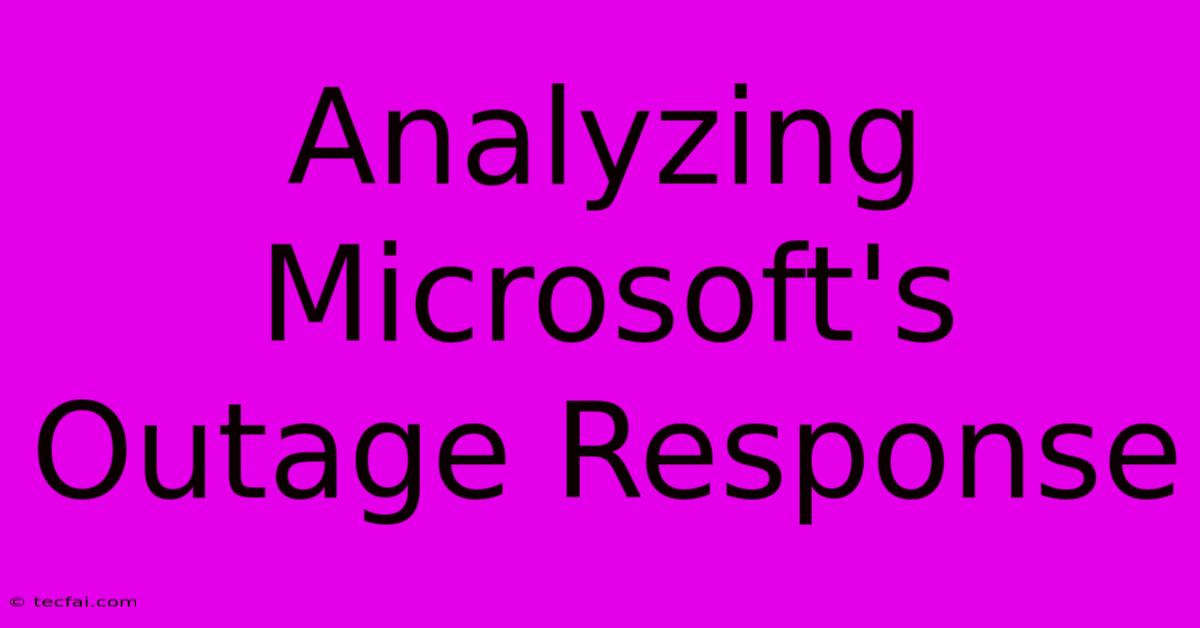Analyzing Microsoft's Outage Response

Discover more detailed and exciting information on our website. Click the link below to start your adventure: Visit Best Website tecfai.com. Don't miss out!
Table of Contents
Analyzing Microsoft's Outage Response: A Case Study in Crisis Communication
Microsoft, a tech giant with a global reach, isn't immune to service disruptions. When outages occur, their response becomes a critical factor influencing user trust, brand reputation, and even financial performance. Analyzing Microsoft's approach to outages provides valuable insights into effective crisis communication and incident management strategies for businesses of all sizes. This article delves into key aspects of Microsoft's outage response, examining both successes and areas for potential improvement.
Understanding the Challenges of Large-Scale Outages
Before analyzing specific responses, it's crucial to acknowledge the inherent challenges faced by companies like Microsoft during large-scale outages. These include:
- Massive user base: Millions of users rely on Microsoft services daily, amplifying the impact of even minor disruptions.
- Complex infrastructure: Microsoft's global infrastructure is incredibly intricate, making pinpointing the source of an outage and implementing a solution a complex undertaking.
- Real-time information dissemination: Effectively communicating updates to a vast, geographically diverse audience in real-time is a logistical hurdle.
- Maintaining transparency and credibility: Open communication is vital during an outage; however, providing accurate, timely information without prematurely committing to solutions is a delicate balancing act.
Key Elements of Effective Outage Communication: A Microsoft Perspective
Microsoft's response to outages generally encompasses several key elements, though the execution and effectiveness vary depending on the specific incident. These elements include:
- Acknowledgement and transparency: Typically, Microsoft acknowledges the outage promptly through its official communication channels, including its status page and social media. This proactive approach demonstrates accountability and prevents the spread of misinformation.
- Regular updates: Consistent updates about the ongoing situation, including the scope of the issue, the efforts being taken to resolve it, and estimated restoration times, are vital. This demonstrates commitment and keeps users informed. Overly vague or infrequent updates can exacerbate user frustration.
- Root cause analysis (RCA): While not always immediately available, a post-incident RCA detailing the cause of the outage and the steps taken to prevent future occurrences builds user confidence. Transparency in this area shows commitment to ongoing improvement and system reliability.
- Multi-channel communication: Utilizing multiple channels — status pages, social media (Twitter, etc.), email alerts (for subscribed users), and potentially even press releases for major incidents — ensures wider reach and caters to different user preferences.
- Empathy and engagement: While factual and technical information is crucial, demonstrating empathy towards affected users can significantly improve the perception of the response. Acknowledging the disruption and inconvenience goes a long way.
Areas for Potential Improvement
Despite generally effective responses, Microsoft, like any organization, can still improve its outage management. Areas requiring further attention include:
- More proactive communication: Sometimes, initial acknowledgement can be slow, leaving users scrambling for information. Faster initial response times would significantly improve user experience.
- Improved estimation accuracy: While providing estimated restoration times is crucial, overly optimistic estimates can damage credibility. More conservative predictions would maintain user trust.
- Enhanced personalization: Personalized communication based on the specific services affected would be beneficial, avoiding overwhelming users with irrelevant information.
Conclusion: Learning from Microsoft's Experiences
Microsoft's outage responses offer valuable lessons for all businesses reliant on technology. By prioritizing transparency, timely communication, and a commitment to root cause analysis, organizations can significantly mitigate the negative impact of service disruptions. Continuous improvement and adaptation, focusing on proactive communication and accurate estimations, will further strengthen their crisis communication strategies. Analyzing past outages, learning from both successes and shortcomings, is vital for building resilient systems and fostering strong user relationships.

Thank you for visiting our website wich cover about Analyzing Microsoft's Outage Response. We hope the information provided has been useful to you. Feel free to contact us if you have any questions or need further assistance. See you next time and dont miss to bookmark.
Featured Posts
-
Geldof Tells Band Aid Critics To Shut Up
Nov 26, 2024
-
Netflix Documentary Jon Benet Ramseys Tragedy
Nov 26, 2024
-
Walking Pneumonia Threatens Teens Life
Nov 26, 2024
-
Former Minister Nikki Kaye Passes Away
Nov 26, 2024
-
Renewed Clashes Israel Hezbollah Defy Eu
Nov 26, 2024
